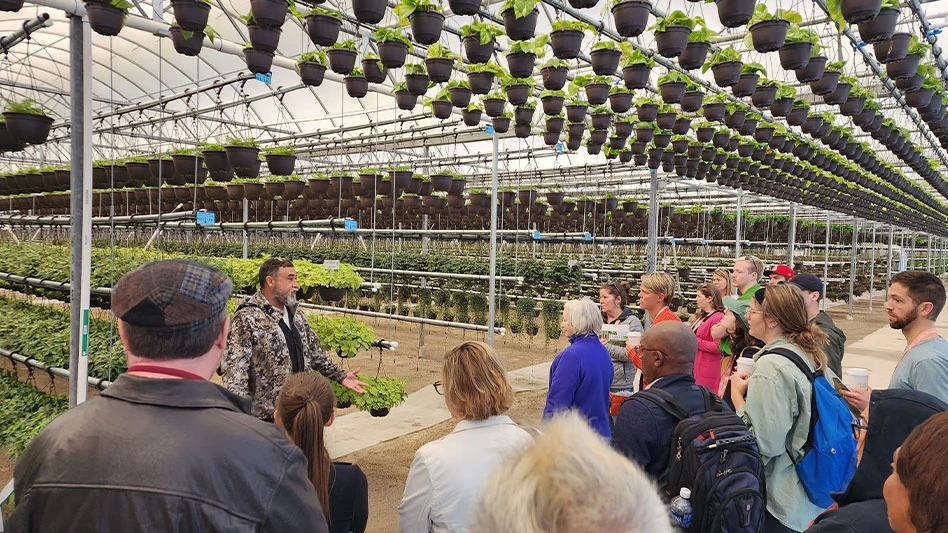.JPG)
Common reed grass, garlic mustard, bush honeysuckle and other plants dominate thousands of acres in Ohio’s forests, grasslands and wetlands. These invaders crowd out native plants and reduce biodiversity. Utilizing a 22-question assessment protocol developed in 2012 by the OIPC and other stake-holder groups, a five-person assessment team of researchers and botanists will evaluate potential invasive plants and establish a new list of primary offenders.
Concurrently, the assessment team will provide a list of alternative plants suitable for recommendation to nurseries, garden retailers and homeowners.
“OIPC is not a regulating group,” said University of Cincinnati professor and OIPC Chairperson of the assessment team, Theresa Culley, PhD. “Our mission is to develop a new list of invasive plants for Ohio. We also intend to play a primary role in education, research and early detection.”
“The nursery industry has already been impacted by unofficial invasive plant lists in Ohio and elsewhere, said Cincinnati Zoo and Botanical Garden Horticulture Director Stephen Foltz. “As soon as we put nursery plants on our official list, these plants will no longer be allowed for use in projects complying with Leadership in Energy and Environmental Design (LEED) standards. That’s why it’s so important for us to get this right.”
“It’s exciting to see that Ohio has a protocol and is ready to begin assessments. This will be a useful tool for addressing the problem of invasive plants,” said Katherine Howe, coordinator of the Midwest Invasive Plant Network.
Under the direction of Culley the assessment team will initially evaluate 27 problematic invasive plants. The team will address a second group of plants within a year, including those produced and sold in Ohio nurseries, such as ornamental pear, Japanese barberry and burning bush.
The OIPC worked with the Ohio Nursery and Landscape Association (ONLA), Ohio Department of Resources (ODNR), The Nature Conservancy and other land-management agencies to develop the assessment protocol. John Cardina, professor of horticulture at The Ohio State University, and Richard Munson, manager of the conservatory at Miami University-Hamilton, were selected by ONLA as representatives on the assessment team.
ODNR botanist Rick Gardner and Dawes Arboretum botanist David Brandenburg were selected by OIPC on behalf of conservation and land-management entities. Culley, a past president of OIPC, directed efforts to develop the assessment protocol during the past four years.
The OPIC represents a coalition of organizations and individuals who have a mutual interest in Ohio's natural ecosystems and the effects of invasive plants. OIPC is a nonprofit organization founded in 2005 working in concert with local, regional and nationwide groups. OIPC assessment documents and other information are available at www.oipc.info.
.jpg) In other invasive plant news, The Pennsylvania Department of Conservation and Natural Resources (DCNR) recently updated their invasive plant list. The list is posted on their web site, and can be downloaded by clicking here.
In other invasive plant news, The Pennsylvania Department of Conservation and Natural Resources (DCNR) recently updated their invasive plant list. The list is posted on their web site, and can be downloaded by clicking here.
This list was discussed at the quarterly meeting of the Pennsylvania Invasive Species Council on Jan. 16. At the meeting, PLNA board members Andy Ernst of Ernst Seeds and Gloria Day of Pretty Dirty Ladies, Inc. raised the concern that the list was developed without an accepted scientific methodology, something that PLNA has been encouraging the council to do for some time.
According to DCNR, the list is intended for use only on state park or state forest lands and is not intended to be a state-wide list with regulatory authority.
Latest from Nursery Management
- Bower & Branch launches Design Studio
- Seed Your Future, NC State launch 2024 Horticulture Industry Salary & Benefits Survey
- Pantone announces its 2025 Color of the Year
- Bug budget boom
- Forest Service selects The Giving Grove to expand community orchards nationwide
- USDA providing $2 billion to specialty crop growers after 2024 hurricanes
- Garden ready
- Spray stakes for nursery production





